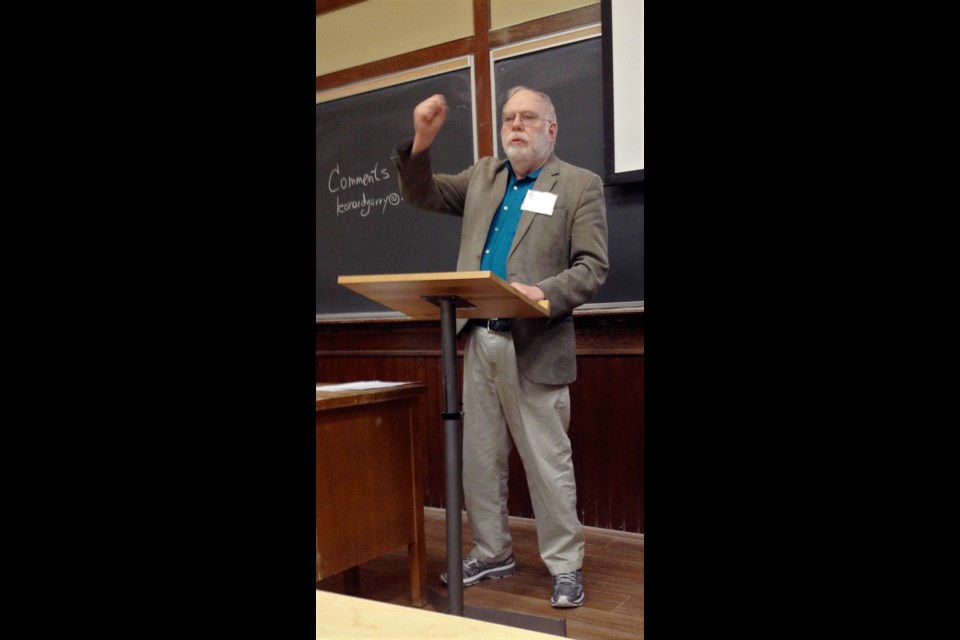They lived und laughed ant lived end left.
— from James Joyce’s Finnegans Wake
 For reasons I have never been able to adequately explain, I have long been fascinated by the writing of James Joyce. His texts have inspired me to create hundreds of paintings, recordings and installations. Last week, I participated in the 2017 James Joyce Conference, held at Victoria College, University of Toronto. This conference has been held in cities in Europe, Britain, Canada and America for many years — some participants have made it an annual event since 1982.
For reasons I have never been able to adequately explain, I have long been fascinated by the writing of James Joyce. His texts have inspired me to create hundreds of paintings, recordings and installations. Last week, I participated in the 2017 James Joyce Conference, held at Victoria College, University of Toronto. This conference has been held in cities in Europe, Britain, Canada and America for many years — some participants have made it an annual event since 1982.
The five-day schedule was daunting: It appeared to be an academic forum for professors of literature presenting “papers” crucial to their pursuit of the tenure track. Half-hour “readings” were scheduled three at a time, from 9 a.m. to 5 p.m., on subjects as esoteric as The Finnish and Swedish Retranslations of Joyce’s Ulysses, or Metempsychosis in Finnegans Wake. Lunch time was given over to round-table discussions of Joycean sex and semantics in which freshmen and old masters traded quips on the subject while munching sandwiches.
On the first day, the man sitting next to me said: “Everyone at this table has made history.” Across from us were Michael Groden, the pre-eminent Joyce scholar and editor of the James Joyce letters; John Gordon, whose books offer the most detailed analysis of all things Joycean; and Carol Schloss, author of the subtle and brilliant biography of Joyce’s daughter Lucia, which was achieved only after years of copyright controversy with the Joyce estate. They were joined by men and women from Japan, the Marshall Islands, Finland, France, Brazil, Mexico and many American states.
Immediately, the invited artists set a tone far beyond dry academic papers. Two American women, Tasha Lewis and Heather Kelley, brought examples of their collaged interpretations of Joyce’s famous books. The Here Comes Everybody Players presented an imaginary dialogue between Joyce and Proust. Astoundingly, a group from Boston called JoyceStick set up a virtual-reality “game.” Donning the goggles and headphones, I found myself transported to the interior of the Martello Tower in Dublin, where the opening chapter of Ulysses is set, and then was swept away to Leopold Bloom’s house at 7 Eccles St. I was lost in an alternate reality until I returned to daylight five minutes later.
Quashing His Quotatoes was a Joycean “karaoke” party in the college chapel, and it took off like a rocket. Derek Pyle of Boston, younger than all the rest, laid down some arching ambient tones on his electric guitar, and Adam Harvey of Santa Fe, New Mexico, leapt to the mike. Harvey has memorized more than 100 pages of Finnegans Wake — an astonishing feat — and he doesn’t mind who knows it. Between takes, a faux priest in cassock delivered the “hell fire” speech from Joyce’s Portrait of the Artist as a Young Man with true conviction. Soon bass and piano soon joined in, and two “contact improvisation” dancers were tumbling all over the stage, and off. This was literary studies with a bullet.
Downtown Toronto in humid summer weather is not appealing, but we were at home in the ivy-clad Victoria College, at the University of Toronto. Breakfast was served in a refectory straight out of Harry Potter, and our headquarters was an ornate Victorian building of dark red stone, creaking wooden hallways and high-ceilinged classrooms hallowed by time, set in a parkland of mature trees. For five days, I scarcely left this oasis.
Time didn’t permit me to attend even half the presentations of ongoing research into Joyce’s astoundingly complex and politically charged writing, often scatological, sexy and hilarious. Novice presenters were accorded respect and engagement by the most seasoned scholars, for there is much to learn.
In addition to the “karaoke” performance, Adam Harvey brought his animated film JoyceGeek, in which words from Finnegans Wake flash on the screen as he says them, his typesetting mimicking Joyce’s careening and cavorting verbiage. Across the hall, Derek Pyle created a listening room for his Internet project Waywordsandmeansigns.com, a website offering the 628 pages of Finnegans Wake read by people from all over the world — and set to music! It’s posted online in its entirely, not once but in three separate editions.
After the banquet, Donna Greenberg of Toronto brought us her song cycle, Thirteen Ways to Say I Love You, based on Joyce’s early poems, Chamber Music. She selected the texts, wrote the music and sang them for us.
Concluding the conference with a round-table discussion, we were sitting in the banquet hall, which was hung all around with my paintings of the “thunderwords.” These are ten words, each one hundred letters long, created by Joyce to mark significant points in Finnegans Wake. Suddenly, the room was jolted by a mighty crack of thunder, something about which Joyce was famously afraid. The emcee noted this coincidence was a fitting conclusion, as a short deluge drenched the campus.
The conference organizers, Garry Leonard and Jennifer Levine, are both professors at the University of Toronto. They took the risk of inviting presenters from outside academia to this scholarly gathering, and it paid off handsomely. For more than 120 participants, it was like summer camp for literary nerds. Next year, the conference will take place in Antwerp, Belgium.
For much more information, look up the following: tashalewis.info; heatherryankelley.com; Derek Pile at Waywordsandmeansigns.com; Here Comes Everybody Players at hce-players.org; joycestick.bc.edu; and donnagreenberg.com and Adam Harvey at Joycegeek.com or on YouTube.



